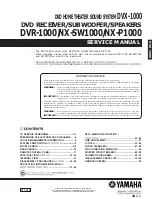
55
> Install
> Playback
Supplementary Information | Advanced Setup |
E
N
Others
USB: 1 (Front, Ver.2.0, 5 V/1 A)
Ethernet: 1
Front Speaker (SKM-648)
Type
Two way sealed
Impedance
6
Ω
Maximum Input Power
130 W
Output Sound Pressure Level
78 dB/W/m
Frequency Response
100 Hz - 20 kHz
Crossover Frequency
8 kHz
Dimensions (W
k
H
k
D)
102 mm
k
170 mm
k
105 mm
4"
k
6-11/16"
k
4-1/8"
(Including grill net and terminal projections)
Weight
1.0 kg (2.2 lbs)
Drivers Unit
Woofer: 8 cm (3-1/4") N-OMF cone
Tweeter: 2 cm (1") balanced dome
Terminal
Push type
Magnetic Shielding
None
Other
Removable grill net
Subwoofer (SKW-B50)
Type
Bass-Reflex
Rated Output Power (IEC)
50 watts minimum continuous power, 4 ohms, driven at
100 Hz with a maximum total harmonic distortion of 1 %
Frequency Response
40 Hz - 200 Hz
Cabinet capacity
11.5 L (0.41 cubic feet)
Dimensions (W
k
H
k
D)
261 mm
k
337 mm
k
269 mm
10-1/4"
k
13-1/4"
k
10-9/16"
Weight
5.8 kg (12.8 lbs)
Drivers Unit
16 cm (6-1/2") cone
Power Supply
AC 220 - 240 V, 50/60 Hz
Power Consumption
15 W
Other
Non-magnetic shielding
Auto standby
Handling
0
These speakers have no magnetic shielding. You may
observe some color irregularity or distortion on a cathode
ray tube television if you use one near these speakers.
Move the television away from these speakers if this
occurs.
0
Note:
Powerful magnets are used in the speakers, so
keep metal objects such as screw drivers away from
them. These objects can damage the diaphragm.
0
Under normal music playback conditions, you should
experience no problems with this unit, but when
particular sounds such as those described below are
introduced, excessive current may occur that cause
circuit burnout.
1
The noise that occurs when FM radio stations are not
tuned
2
High pitched noise from an oscillator, electronic
instrument, etc.
3
Particular signals such as from an audio test CD
4
The howling that occurs with microphones
5
The sound made when cassette tapes are fast-
forwarded
6
When an amplifier oscillates
7
The sharp noise that occurs when plugging or
unplugging pin cables, etc.





































